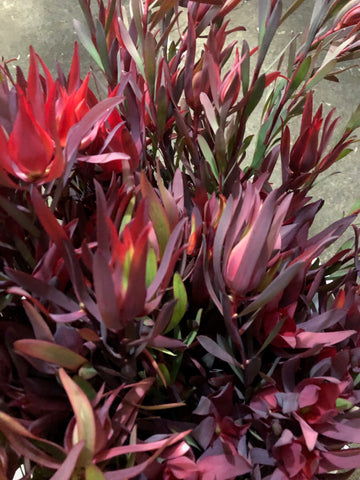Proteas first came to Maui in the late 1960’s via a visiting professor who brought a few protea plants with him from California. He planted those proteas at the University of Hawaii’s College of Tropical Agriculture’s Experiment station in Kula, Maui. A few years latter in 1968, the new station superintendent, Dr. Philip Parvin, noticed that the pincushion protea bloomed in early winter, before they did in California, thus providing flowers before the holidays. This discovery prompted entrepreneurial farmers in Hawaii to invest in Protea. Maui Floral was among those earliest growers of Protea on Maui. Soon after that the Protea industry in Hawaii was underway and the necessity to compete in a world market propelled the search for better Protea plants and flowers. A handfuls of Hawaii’s Farmers and Dr. Parvin began to pinpoint the most prolific species for the Maui environment. It was determined that a special hybridization program for pincushions was the best way forward. Maui Floral worked alongside the UH, College of Tropical Agriculture’s team to support protea hybridization efforts by identifying long-stemmed vigorous growth plants of vibrant colors.
Home Sweet Home… Originating from South Africa and Australia these magnificent Protea flowers have found a tropical island home on the upland slopes of Mount Haleakala. The 3000 foot elevation of Maui Floral’s farm, affords proteas with an ideal environment of warm days and cloud capped afternoons. The cool downward drafts from atop Haleakala create the necessary 25℉ temperature change between day and night that enables the buds to set. Couple the perfect daily temperature with the sloping well drained acidic soil, similar to the soil found in their natural home of South Africa, and you know why Protea thrive on Maui.
Wait … What? In order to truly appreciate the uniqueness of Protea, way before their move from Africa to Maui, you must know that this plant dates back 100 million years. That’s right, back to the time of dinosaurs. Proteas are among the oldest family of plants on earth. That is quite the hearty pedigree… and to top that off there are at least 1400 species of Proteas. They come in different shapes and sizes from shrubs to small trees. So it’s no wonder that in 1735, Carl Linnaeus the father of Modern Taxonomy, named the flower after the Greek God, Proteus. Proteus was the original shape shifter and had the ability to change his shape and form. So Protea is a fitting name for this family of flowers given their myriad variety and diversity of flowers and leaves, colors and shapes.
Fast forward … Currently Maui Floral’s farm cultivates over 55 varieties of Protea on 50 acres. Throughout the year you will find these unique Maui proteas along with other stunning Hawaii tropical flowers in the gift boxes, designer arrangements and bouquets that we ship across the country.
Here are some plant details and a list of many of the Protea curated and cultivated by Maui Floral.

Protea Cynaroides… The King
The King is the largest of all the Protea flowers so they get the most attention but hello their name is King after all. This species is also know as giant protea, honeypot or king sugar bush. The King flowers are predominately pink in color, but occasionally you’ll find rare dark red and almost white kings . The average size of the flower head is 6 inches across! We also grow "baby kings" which measure approx. 4" across., The leaves are dark green with a waxy finish.
Genus ~Protea
Species / Variety - grown at Maui Floral:
Cynaroides / Arctic Ice
Cynaroides / Pale Pink King F2
Cynaroides Pink King
Cynaroides / Red King


Banksia …
Banksia is a genus of around 170 species in the Protea plant family. Banksias grow as trees or woody shrubs. Banksia flowers are usually a shade of yellow, but orange, red, pink and even violet flowers also occur. The leaves of most species have serrated edges, but a few, such as B. integrifolia, do not. Leaves are usually arranged along the branches in irregular spirals, but in some species they are crowded together in whorls.
Genus ~ Banksia
Species / Variety - grown at Maui Floral:
Baxteri / Bird’s Nest Banksia
Speciosa / Showy Banksia
Integrifolia
Prionotes / Orange Frost
Occidentalis
Menziesii / Raspberry Frost
Coccinea / Scarlet Banksia


Leucadendron …
Leucadendron is a genus of about 80 species of flowering plants in the Protea family. Species in the genus Leucadendron are small trees or shrubs that are erect or creeping. All are evergreen. The leaves are largely elliptical, sometimes needle-like, spirally arranged, simple, entire, and usually green, often covered with a waxy bloom, and in the case of the Silvertree, with a distinct silvery tone produced by dense, straight, silky hairs. This inspired the generic name Leucadendron, which literally means "white tree".
Genus ~ Leucadendron
Species / Variety - grown at Maui Floral:
Argenteum (aka Sliver Tree)
Hybrid
Eucalyptifolium
Hybrid / Jubilee Crown
Red Hybrid
Hybrid / Safari Sunset

Leucospermum... aka Pincushion
Leucospermum, is the largest species of the Protea family reaching almost tree-like proportions of 16–20 ft high, with large yellow / orange flowerheads, with firm, bent, yellow / orange styles that stick far beyond the rest of the flower and give the impression of a pincushion. The flower heads sit atop a stalk and are globe- to egg-shaped, and are approximately 2.8–3.5 inches in diameter. They can be found individually or mostly with two or three flower heads together near the tip of the branch.
Genus ~ Leucospermum
Species / Variety - grown at Maui Floral:
Yellow-ish Pincushions:
Hybrid / Kathryn
Hybrid / Mary Lou
Hybrid / High Gold
Hybrid / Cliff’s Delight
Hybrid / Shannon
Hybrid / Cloudbank
Hybrid / Dawna
Hybrid / Brandi Dela Cruz
Hybrid / Gold Finger
Hybrid / Luz Miguel
Hybrid / Jody Jewell
Hybrid / Henny’s Torch
Pink-ish, Orange Pincushions:
Hybrid / Maui Magic
Hybrid / Candlelight
Hybrid / Lillian’s Peach
Hybrid / Blanche Ito
Hybrid / Naomi
Hybrid / Lani
Hybrid / Ali’i
Hybrid / Kristen
Hybrid / Zell


Nerifolia… aka Minks
Protea neriifolia, also known as the narrow-leaf sugarbush, oleander-leaved sugarbush, blue sugarbush, or the oleander leaf protea. The flower heads are cup-shaped. The outer bracts range in colour from carmine to pink to creamy-green or whitish, this colour contrasts with the characteristic hairy black fringe on the margins of the apex of the bract. The inner bracts are shaped oblong to spatulate, and are typically curved inwards at the tips. These tips are rounded and also covered in a black, sometimes white, beard of fuzzy hairs.
Genus ~ Nerifolia
Species / Variety - grown at Maui Floral:
Compacta / Pink Ice
Nerifolia / Annette
Nerifolia Selection / Pink Mink
Lepidocarpodendron
Laurifolia . rose Mink
- / Red Mink
Nerifolia / Cup & Saucer
Repens / Surarbush
Compacta / Andrea
- / Regina
Eximia x / Sylvia

- The Macadamia Nut tree (Macadamia integrifolia) is in the Protea family and is considered by many people to be the most delicious nut in the world and consequently is one of the most expensive. It is native to Australia but primarily cultivated in Hawaii and Southern California.
- Proteas are also known as sugarbushes, due to the excessive amount of nectar the flowers produce.
- Proteas can survive wildfires - Dormant buds survive the wildfires that often clear dry land, only to emerge once the fire has gone out. The plants are, as such, hardy and can withstand the toughest of weather conditions.
- All proteas have a proteoid root system - One thing that ties all of the differently shaped and sized proteas together is their root system. The proteoid root system allows them to survive in soil that is not rich in nutrients.




Leave a comment